Experimental Highlights - 2014
November
DIXI Reveals New Hot-Spot Details
The first images of the evolution of the central hot spot throughout the entire burn time of a NIF implosion have been captured by the world’s fastest x-ray framing camera.
DIXI (the Dilation X-ray Imager) acquired the images during a cryogenic layered deuterium-tritium (DT) experiment on Nov. 16. The experiment used an ignition-scale near-vacuum hohlraum and a tungsten-doped high-density-carbon (diamond) capsule driven with a two-shock laser pulse. The experimental yield was 1.2 × 1015 (1.2 quadrillion) neutrons.
The DIXI images showed rapid evolution of the hot spot and revealed spatial structures not evident with the much slower traditional framing camera, such as an early-time central emission feature.
 DIXI’s 10-picosecond temporal resolution shows hot-spot details (top row) not evident with a traditional slower 100-picosecond framing camera (bottom row). The images of a Nov. 16 deuterium-tritium implosion were taken from about 60 picoseconds before bang time (BT) to 100 picoseconds after bang time. (Bang time is the time interval between the start of the laser pulse and peak x-ray emission from the fuel core.)
DIXI’s 10-picosecond temporal resolution shows hot-spot details (top row) not evident with a traditional slower 100-picosecond framing camera (bottom row). The images of a Nov. 16 deuterium-tritium implosion were taken from about 60 picoseconds before bang time (BT) to 100 picoseconds after bang time. (Bang time is the time interval between the start of the laser pulse and peak x-ray emission from the fuel core.) DIXI, a two-dimensional x-ray imager with a temporal resolution of about five picoseconds, is capable of recording a frame every five trillionths of a second—the equivalent of 200 billion images a second (see Science & Technology, August 2014). The camera was developed by an international team including researchers from General Atomics, the UK’s Kentech Instruments, Ltd., and LLNL.
“DIXI acquired fantastic data showing structure never seen before,” said NIF Operations Manager Bruno Van Wonterghem. “Congratulations to the members of the DIXI team at General Atomics, Kentech, and LLNL for this initial demonstration of DIXI’s potential contributions to NIF.”
Controlling Hydrodynamic Mixing in NIF Implosions
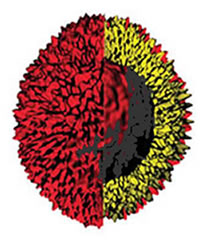 These density isosurfaces from a simulation of a NIF ignition capsule using the HYDRA three-dimensional radiation hydrodynamics code show the irregularities that result from Rayleigh-Taylor instabilities. The outer surface is near the ablator-fuel interface, and the inner surface is in the deuterium-tritium fuel. Fingers of dense material (spikes) interpenetrate the less dense fluid (bubbles), leading to a mixture of the layers of fluid.
These density isosurfaces from a simulation of a NIF ignition capsule using the HYDRA three-dimensional radiation hydrodynamics code show the irregularities that result from Rayleigh-Taylor instabilities. The outer surface is near the ablator-fuel interface, and the inner surface is in the deuterium-tritium fuel. Fingers of dense material (spikes) interpenetrate the less dense fluid (bubbles), leading to a mixture of the layers of fluid. While it’s true that oil and water don’t mix—unless you add detergent—the same unfortunately isn’t true for the target capsule material and the fusion fuel in NIF inertial confinement fusion (ICF) experiments.
In fact, one of the most significant challenges to achieving ignition on NIF has been understanding and controlling the growth of mixing caused by hydrodynamic instability, a type of fluid dynamics, in the imploding fusion fuel as it’s compressed. Rayleigh-Taylor (RT) and Richtmyer–Meshkov (RM) instabilities can lower ICF capsule performance by substantially degrading the ablator’s ability to compress the fusion fuel and by mixing ablator material into the fuel.
The RT and RM instabilities occur when fluids of different densities, such as the material in the outer layers of an imploding NIF target capsule (the ablator) and the hydrogen fusion fuel inside the capsule, are accelerated together (RT) or shocked (RM) and begin to interpenetrate at their boundary. High levels of fuel-ablator mixing occurred in many of the implosions studied during the National Ignition Campaign (NIC), which failed to approach ignition conditions even though ignition-relevant implosion velocities were reached. Suspecting that the mixing might be due to capsule surface roughness, a multi-institutional Science of Ignition workshop recommended in 2012 that NIF conduct experiments with a roughened ablator and the full NIC drive pulse and compare the results against the predictions of simulations.
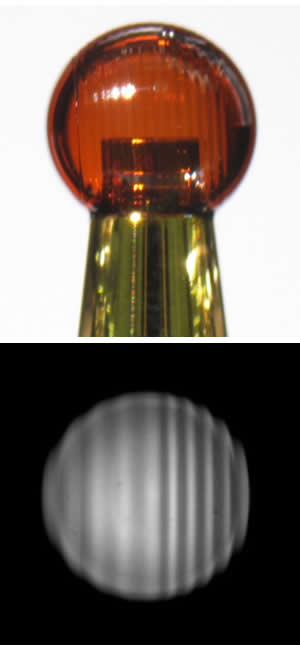 (Top) The “rippled” target capsule used in focused HGR experiments to validate simulation codes. (Bottom) High-magnification image of the backlit diagnostic centerline of a capsule with Legendre mode (wavelength) 60 and 90 modulations, used to align the modulation to the hohlraum axis during assembly.
(Top) The “rippled” target capsule used in focused HGR experiments to validate simulation codes. (Bottom) High-magnification image of the backlit diagnostic centerline of a capsule with Legendre mode (wavelength) 60 and 90 modulations, used to align the modulation to the hohlraum axis during assembly. The result was the development of special target capsules with pre-imposed sinusoidal modulations, or “ripples,” with various wavelengths on the capsule surface for use in a series of hydrodynamic growth radiography (HGR) experiments. The experiments measured the growth of hydrodynamic instabilities as a function of the wavelength of the ripples. They tested instability growth for two ignition-relevant laser drives: the “low-foot” drive used during NIC, and the new “high-foot” pulse shape (see the February 2014 Photons & Fusion Newsletter). The HGR platform has been tested up to a convergence ratio of four (convergence ratio is the initial radius divided by the imploded radius).
The high-foot implosions have a higher adiabat (more internal energy, making for lower density at the same pressure) than their low-foot counterparts due to the higher initial laser pulse, and were predicted to be less prone to hydrodynamic instability. The experiments showed that unstable growth at the ablation front was indeed dramatically reduced in recent implosions with high-foot drives, which helps to improve the performance of layered deuterium-tritium (DT) implosions when compared to the previous low-foot experiments.
On Oct. 31, Don Cook, deputy administrator for Defense Programs at the National Nuclear Security Administration (NNSA), presented an NNSA Defense Programs Award of Excellence to the High-Foot Team. The award citation noted that the High-Foot Team used face-on HGR experiments to directly test the degree of ablation front stabilization gained from the high-foot pulse shape, and the implosions show low levels of inferred mix and excellent agreement with one- and two-dimensional implosion models without the aid of mix models.
Fabrication and metrology of the tiny capsules—about the size of a peppercorn—with the high-quality sinusoidal ripples required by the experiments, and design of the targets to allow radiography of the ripples, were significant research and development challenges for the target fabrication teams at General Atomics (GA) of San Diego and LLNL. The GA target fab team used diamond-turning techniques for producing the modulations on plastic shells, and laser ablation for high-density carbon (diamond) shells. The LLNL team developed the design of the target and a cryogenic cone-on-shell assembly.
LLNL lead engineer Jeremy Kroll said the LLNL team was able to leverage many existing target assembly techniques, “but HGR created at least three unique challenges. First, the HGR capsule modulations needed to be aligned to within plus-or-minus five-tenths of a degree of the hohlraum axis. This required development of tooling and techniques for assembly under an optical coordinate measuring machine.
“Second,” he said, “ HGR also required the inner surface of the gold cone to be coated with plastic to prevent gold from ablating into the radiography line-of-sight, which would blank the image. This required significant process and tooling development. And finally, when assembling the capsule onto the gold cone, we needed to develop tooling to hold the capsule in place during gluing without damaging the capsule modulations.”
 LLNL target fab technician Tony Tambazidis uses an optical coordinate measuring machine to align an HGR target in a hohlraum.
LLNL target fab technician Tony Tambazidis uses an optical coordinate measuring machine to align an HGR target in a hohlraum. Along with validating model predictions of single mode instability growth and testing the effects of different pulse shapes, the HGR experiments are being used to study the role of capsule surface roughness, target features such as the capsule support “tent” inside the hohlraum—which had been suspected of contributing to hydrodynamic instabilities—and the stability aspects of alternate ablators such as diamond and beryllium.
“HGR was initiated as a high energy density (HED) experiment to validate models of ICF instability growth,” said physicist Kumar Raman of LLNL’s Weapons and Complex Integration (WCI) directorate, who led the design effort during development of the HGR platform. “Before the HGR experiments, there was considerable uncertainty about the ability of our models to predict instability growth in this new physical regime. Therefore, much of the design effort was spent in making the platform robust enough to accommodate scenarios where the design models differed significantly from reality.
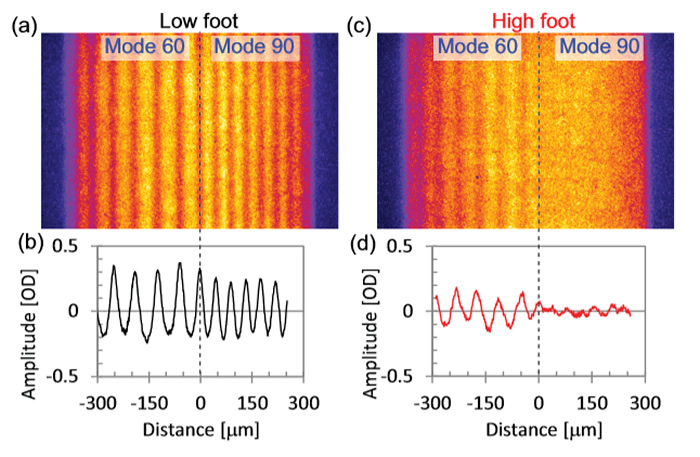 Slit image radiographs of modulation growth captured on an x-ray imager using the low-foot (left) and high-foot pulses. (a) Slit image radiograph of side-by-side, preimposed, single-mode ripples of Legendre mode (wavelength) 60 and 90, for the low-foot pulse at 20.6 nanoseconds, which corresponds to a radius of 613 microns. (b) Horizontal line-out in optical depth of the slit image shown in (a). (c) Slit image radiograph at 14.8 nanoseconds driven with the high-foot pulse, which corresponds to a radius of 600 microns for the same side-by-side modes. (d) Horizontal line-out in optical depth of the slit image shown in (c).
Slit image radiographs of modulation growth captured on an x-ray imager using the low-foot (left) and high-foot pulses. (a) Slit image radiograph of side-by-side, preimposed, single-mode ripples of Legendre mode (wavelength) 60 and 90, for the low-foot pulse at 20.6 nanoseconds, which corresponds to a radius of 613 microns. (b) Horizontal line-out in optical depth of the slit image shown in (a). (c) Slit image radiograph at 14.8 nanoseconds driven with the high-foot pulse, which corresponds to a radius of 600 microns for the same side-by-side modes. (d) Horizontal line-out in optical depth of the slit image shown in (c). “HGR was part of the same WCI-HED ignition science effort that spawned the high-foot campaign and viewfactor and alternate ablator platforms,” he said, “and it involved a close collaboration between WCI and NIF&PS. The experiment was developed within the mix campaign of the ICF program and, in Fiscal Year 2014, transitioned to being an ICF experiment. It is currently being used by the ICF program to investigate a variety of issues that will impact future ignition designs.
“The experiments have provided new insights into a number of modeling aspects that impact our ability to predict instability growth,” he added, “including the way in which shock timing and viewfactor data are incorporated into the simulations. The results so far have largely validated the tuned drive approach to modeling instability growth used in state-of-the-art ICF calculations.”
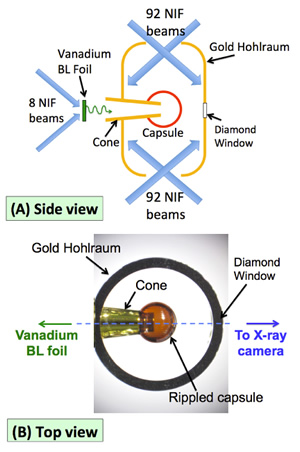 Diagram of the HGR experiments (side view not to scale)
Diagram of the HGR experiments (side view not to scale) In the experiments, 184 of the 192 NIF laser beams are focused on the hohlraum walls, generating soft x-rays which drive the capsule, with peak drive corresponding to radiation temperatures around 300 electron volts (eV). The remaining eight beams are focused on a 12.5-micron-thick vanadium foil outside the hohlraum to generate 5.4-keV backlighter x rays which radiograph the capsule in flight. The backlighter x rays enter the hohlraum through the cone, pass through the rippled capsule surface, and exit the hohlraum through a window toward a gated x-ray camera.
LLNL’s Luc Peterson, who took over the design work for the HGR experiments at the beginning of FY14, said that while the implosion models do an adequate job of simulating the hydrodynamic growth of known perturbations, the researchers are now extending the measurement “to look at capsules with potentially unknown ‘native roughness’ perturbations. We are also using the HGR platform to test theories on how to control growth in next-generation implosion designs,” he said. “As we push toward ignition, it will be important to keep hydrodynamic instabilities in check; the HGR experiments help us stay on the right track.”
“One remarkable feature of the results is the experimental confirmation that the instability growth is close to what the codes predict,” added LLNL researcher Steve Haan. “While these results do confirm the expected reduction in growth with the high-foot pulse, they do not explain why the low-foot shots behaved as if they had larger-than expected growth. Exploring that puzzle is a top priority for future work.”
Participating in the HGR experiments along with Raman, Peterson and Haan were LLNL colleagues Vladimir Smalyuk, Dan Casey, Omar Hurricane, Bruce Remington, Harry Robey, Dan Clark, Bruce Hammel, Nino Landen, Marty Marinak, David Munro, and Jay Salmonson; and Kyle Peterson of Sandia National Laboratories. The GA target fabrication team included Martin Hoppe, Jr., Anna Nguyen, Neal Rice, Lane Carlson, Denise Hoover and Abbas Nikroo. The LLNL team was composed of Lucian Sweitzer, Steve Andrews and Jack Reynolds, who developed the cone plastic coating process; Jean Jensen and Elias Piceno, who developed the capsule loading fixture process and the modulation alignment process; and the engineering team of Kroll, Dave Barker, Suhas Bhandarkar, Brian Yoxall and Nick Hash.
MIT’s Mighty-Mite Detectors Prove Their Mettle
One of the key elements in a successful NIF ignition experiment is maintaining the symmetry of the fusion fuel’s areal density as it implodes. Areal density, known as ρR (rho-R), is the combined thickness and density or “stiffness” of the fuel during the implosion. A small but extremely useful diagnostic for measuring ρR symmetry as the fuel is compressed prior to reaching maximum density is the wedge range filter (WRF) developed at the Massachusetts Institute of Technology (MIT).
Used on both NIF and the OMEGA Laser Facility at the University of Rochester, WRFs are precision compact proton spectrometers employed to diagnose ρR asymmetries at “shock flash bang time,” when the fuel has converged (been compressed) to about four times smaller than its initial diameter. The WRF is one of four diagnostic devices created at MIT designed to measure the spectrum and timing of neutrons and protons released during NIF implosions.
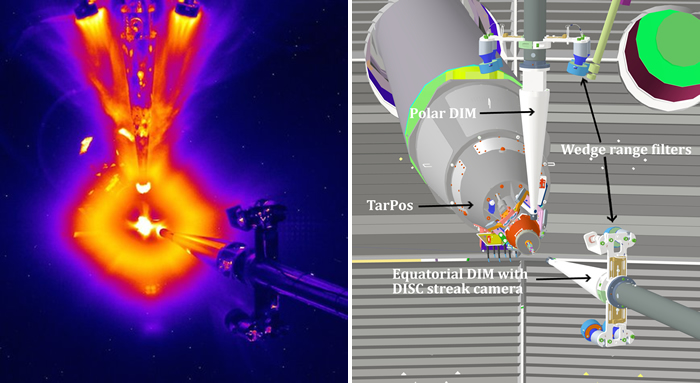 (Left) NIF’s Don Jedlovec captured this spectacular color-enhanced photo of glowing plasma during an Oct. 2 NIF experiment. One megajoule of laser energy irradiated a convergent ablator shock-timing target as it was being measured by eight wedge range filters (WRFs) and a DIM imaging streak camera, or DISC, mounted on diagnostic instrument manipulators (DIMs) inserted into the NIF Target Chamber. Four WRFs are at the pole (top) and four at the equator (lower right), along with the DISC. The WRF units are about 50 centimeters from the imploding target held by the target positioner (TarPos). A shot-triggered, two-megapixel monochrome Basler 641f science camera with a 16mm lens was used to capture the time-integrated image. (Right) CAD image by Paul Bloom shows the configuration of the equipment for the experiment.
(Left) NIF’s Don Jedlovec captured this spectacular color-enhanced photo of glowing plasma during an Oct. 2 NIF experiment. One megajoule of laser energy irradiated a convergent ablator shock-timing target as it was being measured by eight wedge range filters (WRFs) and a DIM imaging streak camera, or DISC, mounted on diagnostic instrument manipulators (DIMs) inserted into the NIF Target Chamber. Four WRFs are at the pole (top) and four at the equator (lower right), along with the DISC. The WRF units are about 50 centimeters from the imploding target held by the target positioner (TarPos). A shot-triggered, two-megapixel monochrome Basler 641f science camera with a 16mm lens was used to capture the time-integrated image. (Right) CAD image by Paul Bloom shows the configuration of the equipment for the experiment. Commonly used on all deuterium and deuterium-helium3-fueled NIF implosions, the WRF proton spectrometers, designed by MIT’s Fredrick Seguin, measure the spectrum of proton energy in the range from four million to 20 million electron volts (MeV) using a wedge-shaped aluminum filter placed in front of plastic film called CR39. The WRFs measure the energy downshift of the protons as they leave the implosion to determine the implosion areal density at the shock flash bang time, which happens several hundred picoseconds before the main compression fusion burn.
 (Left) NIF diagnostic technician Wayne Abreu installs four wedge range filters on a diagnostic snout. (Right) Michelle Valadez loads a WRF into a holder for chemical etching to remove excess plastic material and expose the data captured on the tracks of the WRF’s CR-39 “coupon” (detector). The coupons are then scanned and the results are sent to MIT for analysis.
(Left) NIF diagnostic technician Wayne Abreu installs four wedge range filters on a diagnostic snout. (Right) Michelle Valadez loads a WRF into a holder for chemical etching to remove excess plastic material and expose the data captured on the tracks of the WRF’s CR-39 “coupon” (detector). The coupons are then scanned and the results are sent to MIT for analysis. The energy spectrum of the escaping protons is measured with CR-39 track detectors after they pass through various parts of the wedge. “CR-39 is a special plastic film that is cut up into small ‘coupons’ and used in nuclear diagnostic systems,” said NIF User Facility Manager Doug Larson. “The process was perfected by MIT scientists led by Rich Petrasso (head of the HED physics division at the MIT Plasma Science and Fusion Center).”
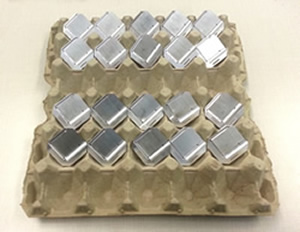 Close-up of 20 WRFs, about three centimeters at their largest dimension. The WRFs are precision machined from aluminum; the thinnest part of the wedge is 140 microns and the thickest part is 2,000 microns. After about 15 NIF shots, individual spectrometers suffer sufficient surface damage and erosion that a new set is usually deployed.
Close-up of 20 WRFs, about three centimeters at their largest dimension. The WRFs are precision machined from aluminum; the thinnest part of the wedge is 140 microns and the thickest part is 2,000 microns. After about 15 NIF shots, individual spectrometers suffer sufficient surface damage and erosion that a new set is usually deployed. The material currently is used in three NIF diagnostics: the WRFs; their even-smaller offspring, the step range filter (SRF) proton spectrometers; and the Magnetic Recoil Spectrometer (MRS), also developed at MIT in collaboration with the Laboratory of Laser Energetics (LLE) at the University of Rochester. All three diagnostics were developed and tested at LLE before fielding on NIF. (The particle-time-of-flight diagnostic, which helps determine the timing of fusion reaction particles using a diamond detector that responds to both protons and neutrons, is the fourth MIT diagnostic used on NIF.)
The nuclear particles leave “tracks” in the CR-39 plastic as they pass through it, and these tracks can later be revealed by etching in a strong base solution. A scanning process counts and characterizes the tracks that were revealed during etching. “The number and diameter of the tracks tell the physics team about the number and energy of the particles,” Larson said. The technique yields valuable data about the dynamics of the final strong shock in a NIF implosion prior to the full compression of the capsule ablator.
The operations and upgrades of the accelerator used to calibrate the WRFs are done by MIT PhD students and postdocs at the Plasma Science and Fusion center under the direction of Maria Gatu Johnson. PhD student Alex Zylstra and former student Mike Rosenberg, who recently received his PhD, are directly involved in working with WRF results. The WRFs are processed in LLNL’s Etch/Scan laboratory in Bldg. 490 by Michelle Valadez under the supervision of Richard Bionta, the physicist for nuclear diagnostics. Minda Cairel of Laser Systems Engineering also has served in the lab.



